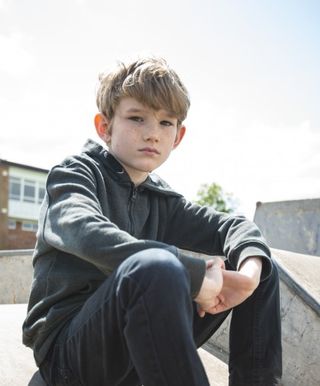Essential ideas, tips and techniques to transform your portrait photography
Improve your portrait photography with our expert guide
3. Using off-camera flash

When you shoot portraits purely with natural light, you're usually restricted to one 'correct' exposure. But when you start to mix natural light with flash, then you can manipulate the exposure to suit your artistic means.
Any time that you work with two different light sources, the key is all about the ratio between the two. You can't control the power of the sun, for example, but you can change your speedlight power to alter the ratio between the two – as we've shown here by overpowering the midday sun for a dramatic moody portrait.
Notice how the boy's hair has the look of a studio portrait with a nice hair light to bring out detail and texture. But this is in fact sunlight. Posed with his back to the sun, the natural light hits his hair, making it shine. By underexposing the shot for natural light, we effectively transform the sun into our secondary light source. Then we simply lift the face with our flash. Here's how you can achieve similar results in just a few steps, with the help of an off-camera flashgun and the sun…
Step 1: Set up

All you need for this is a speedlight fixed to a stand with a silver umbrella attached, plus an ND filter and a means of triggering the flash off-camera, like radio triggers, a sync lead or your camera's wireless flash system. (We used Nikon's commander mode with the SB-900 here). Direct the speedlight into a silver umbrella for soft, diffuse light.
Step 2: Expose for ambient light

Don't turn on the flash yet. Instead, set the camera to Manual mode and work out an exposure for the ambient light. If it's very bright, start with ISO 100 and a shutter speed of 1/200 sec, then adjust the aperture in further shots until the face is correctly exposed. Here we had f/4. With his back to the sun, this correctly exposes the face but blows out the sky.
Step 3: Underexpose with filters

Next, underexpose the ambient light. You could do this by tightening the aperture, but then you'd also increase depth of field, and in this case you want it shallow to blur the background. So instead, add an ND filter and a polariser. The two filters combined block out about four stops of light, which makes the sky look better but leaves the face far too dark.
Step 4: Light the face

Now you can turn on your flash. On a sunny day you'll be working at the power limits of most speedlights, so start in Manual at full (1/1) power, then reduce if necessary. We positioned our flash (bounced off our silver umbrella) directly above the face here (about a metre away), with a silver reflector placed on the ground to bounce light back up into the shadows.
Get daily insight, inspiration and deals in your inbox
Get the hottest deals available in your inbox plus news, reviews, opinion, analysis and more from the TechRadar team.
- Learn more: Flash photography made easy
